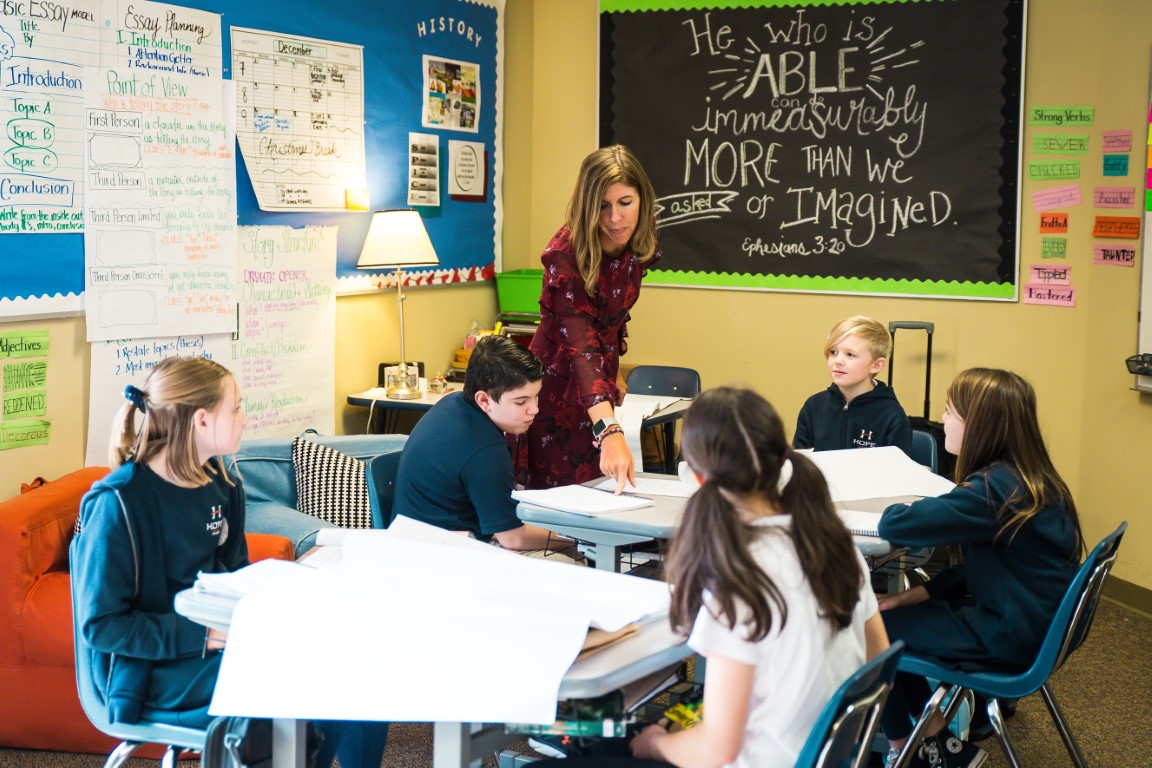Written by Courtney Elliott Head of School and Co-Founder of HOPE Academy
Hope Academy students courageously develop their Christ-like identity, cultivate their unique gifts, and engage as active learners within an authentic community.
One of the ways we advance the mission of HOPE Academy in the lives of students as active learners is through Project-Based Learning. In 2019, we transitioned from being “project-oriented” to implementing a Project-Based Learning methodology. We went from 3rd graders creating slide presentations on Ancient Egypt to creating an escape room where participants experienced unique aspects of ancient Egypt as they solved student-created clues, in a space that the students designed and narrated. In the weeks leading up to the project, students worked in small groups surrounded by books, articles, and images all related to Egypt. Commonly, a student would rush into class in the morning excited to share something they had created for their escape room the night before simply because they were so enthusiastic about the project. In PBL, a project is “launched” with a creative activity that builds student anticipation. In this project, students traveled to a local escape room and met with experts to learn the essentials of escape room design. Students enjoyed learning at HOPE prior to 2019, but what happened when we began doing true PBL was electrifying, both for our students and our teachers. The energy for PBL across our campus sparked a new level of student engagement!

Multidisciplinary collaboration and dreaming big led to a 6th-grade science and humanities PBL unit where our students were originally designing hand-held boats that would float in a baby pool, to learning the scientific method and science concepts by building two-person boats that they would set sail in a nearby lake. As a mom, I watched my daughter design multiple prototypes at home because she wanted to, not because she was asked to. In the weeks leading up to the boat build, our bathtub at home was perpetually filled with water, and the floor was piled with shampoo bottles and weights that she used to determine the right size and weight ratio according to what her team would need to stay afloat.
PBL Works defines Project Based Learning as a “teaching method in which students gain knowledge and skills by working for an extended period of time to investigate and respond to an authentic, engaging, and complex question, problem, or challenge.”
True PBL is a response to a real-world problem or question and involves critical thinking and collaboration both with peers and often professional experts. It requires communication and perseverance to work through multiple iterations based on critique and feedback, and it offers students the opportunity to have both voice and choice, as they produce something for an authentic audience. Through the implementation of high-quality PBL, student engagement, personal ownership, and shared responsibility are at the forefront of the student’s experience.
The Buck Institute for Education’s Design Elements and Teaching Practices for Project-Based Learning have helped guide our school’s practice and growth goals year over year.

There is a growing body of research that provides evidence that PBL is a successful pedagogical approach. In the 2015 Edutopia article, Project-Based Learning Research Review, the following was reported:
Studies comparing learning outcomes for students taught via project-based learning versus traditional instruction show that when implemented well, PBL increases long-term retention of content, helps students perform as well as or better than traditional learners in high-stakes tests, improves problem-solving and collaboration skills, and improves students’ attitudes toward learning (Strobel & van Barneveld, 2009; Walker & Leary, 2009). PBL can also provide an effective model for whole-school reform (National Clearinghouse for Comprehensive School Reform, 2004; Newmann & Wehlage, 1995).
A 2016 MDRC/Lucas Education Research literature review found that the design principles most commonly used in PBL align well with the goals of preparing students for deeper learning, higher-level thinking skills, and intra/interpersonal skills (Condliffe et al., 2016).
As a school, we value methodologies backed by educational research, and even more we value student-centered pedagogical practices that promote opportunities for our students to cultivate their unique gifts and engage as active learners doing work that has transformational impact. Beyond escape rooms, and setting sail on student-designed boats, many of our PBL units provide opportunities for our students to have an impact through service and by developing deep connections with people across our local community and around the globe. Whether it is through a language and cultural exchange with high school students at the Cab School in Guatemala, our 5th graders providing tools for people to manage both the literal and figurative storms of life, developing and implementing plans to get books in the hands of children who live in zip codes that are considered “book deserts,” or 8th-graders developing our school’s Student Council program through their study of government, HOPE Academy students know that their learning isn’t just about themselves, but it is about others, too.

PBL would not have been a dream realized at HOPE Academy without a team of teachers who are courageous, willing to take risks, unafraid of failure, have strong content knowledge, pedagogical understanding, and most of all who know their students. God has been gracious in continuing to provide a team of incredible educators who are willing to shoot for the moon and make doing what is best for kids their first filter for excellent mission delivery at HOPE Academy.


